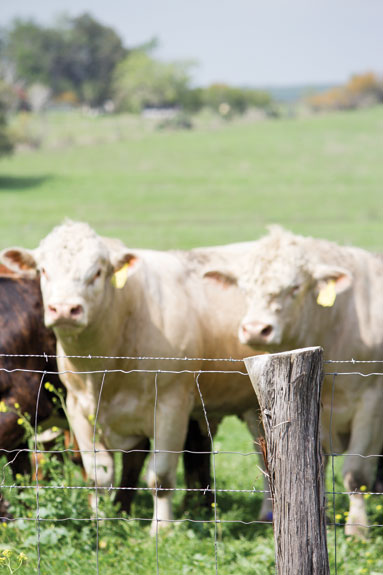Fencing costs are dependent on what type of fence will be built.
A person can spend a tremendous amount of money on a fence when the fence is more decorative than it is functional.
While most ranchers want their fences to look good, they are more interested in the fence doing the job at the least cost. The most common fence used on ranches today is the standard four-strand or five-strand barbed wire fence with either steel or wooden posts.
When considering the use of barbed wire fencing, ranch managers need to ask the following questions:
- Is this the best type of fence for my operation?
- What are the alternatives to barbed wire fences?
- What are the costs to build and maintain the various fencing options?
- What type of fence will meet the definition of a legal fence?
- Who is responsible for maintaining fences?
Let’s analyze each of these questions.

Fencing options
- Woven wire fence: This is a popular fence for producers that run not only cattle but sheep as well. The bottom section of the fence has the woven wire with one strand of barbed wire at the top of the fence. This fence helps keep some predators out of the pasture and keeps smaller animals in. However, this type of fence is not as practical for large land owners.
- Barbed wire fence: The most common fence found on ranches across America. The fence can be four or five strands and is very functional.
- High-tensile non-electric wire fence: This fence features the 12.5-gauge smooth wire with eight strands on the fence.
- High-tensile electrified wire fence: This fence also uses the 12.5-gauge smooth wire but only has five strands of wire on the fence. The top wire, middle wire and bottom wire are electrified while the second and fourth wire from the top are ground wires.
What are the costs?
In February 2012, William Edwards, an extension economist from Iowa State University, and Andy Chamra, a student at ISU, revised a paper written by Ralph Mayer and Tom Olsen, also from ISU, titled “Estimated Costs for Livestock Fencing.”
In this publication, Edwards outlined the costs, on a per-foot basis, for each of the fences discussed above. Edwards based his costs on building a quarter-mile stretch of fence on flat land. Below are the estimated costs Edwards developed:
- Woven wire fence = $1.93 per foot.
- Barbed wire fence = $1.48 per foot
- High-tensile non-electric fence = $1.24 per foot
- High-tensile electric fence = $0.89 per foot
The Natural Resources Conservation Service (NRCS) also has fencing cost estimates they use to figure the cost share for participants in their farm programs. According to the latest NRCS estimates, a barbed wire fence costs over $2 per foot to build.
So as you can see, the estimated cost of a barbed wire fence varies between $1.50 to over $2 per foot. In any case, building fence is expensive and the costs continue to increase.
In fact, a survey conducted by Jen Schlegel and Leah Tsoodle from Kansas State University in 2010 showed how much fence building materials had increased in price since 2006 in Kansas.
The survey findings were interesting. According to the survey, material costs increased substantially. The increases were:
- Corner posts = up 25 percent
- 5-1/2-foot steel T posts = up 22 percent
- Treated wood posts = up 12 percent
- Barbed wire – 2 pt. 12.5-gauge = up 36 percent
- Labor – fence building per rod (one rod = 5.5 yards) = up 41 percent
Definition of a legal fence in Idaho
The Idaho Code defines a legal fence as:
- If made of stone, it must be four feet high, two feet wide at the base and one foot thick on top.
- Worm fences – the rails must be laid four feet high.
- Posts with boards or rails – the posts must be well set in the ground, not more than eight feet apart, with the combination of boards or poles not less than four feet from the ground.
- Wire fence – posts must not be more than 24 feet apart, the wire must be tight and not less than 47 inches high.
- If made of brush, hedge, ditch or any other material, it must be equal in strength to turn livestock as other fences listed above.
- All fences in good repair – creeks, brooks, rivers, ponds, hills, bluffs, mountains that present a suitable obstruction to stock are deemed lawful fences.
Be sure to research your state’s legal definitions of a fence or call your nearest university extension officer to learn it.
Who is responsible for the fence?
The responsibility to maintain or erect a fence to separate land between two landowners depends on the existence of a herd district or if the property is located in an area designated as open range.
In open range areas, stock can roam anywhere. If a landowner does not want the stock on his/her property, it is their responsibility to fence the animals out. The owner of the stock has no fencing obligation.
In areas with herd districts, adjoining landowners are responsible for fencing. The Idaho Code also addresses this issue. The code states:
“Each adjoining land owner, unless both otherwise agree, or unless other arrangements have heretofore been made, must construct and keep in repair that half of the line fence which is to his left when standing on his own land facing the other.”
Fencing laws may vary from state to state so be sure to check the laws in your state.
Summary
Landowners need to decide which type of fence will work best for them. Large producers with big pastures will probably want to stick with barbed wire fences.
Smaller operations have more options. They can look at woven wire fences if they need to graze multiple species. The smooth wire high-tensile fences, both electric and non-electric, can also be considered.
The costs associated with building and maintaining fences continue to rise and, according to the study conducted at Kansas State University, the increases are very large.
Maintaining fences will always be less expensive than paying to rebuild neglected fences. Remember: Good fences make good neighbors. Good luck with your fencing jobs this year. ![]()
References omitted but are available upon request. Click here to email an editor.
PHOTO
While most ranchers want their fences to look good, they are more interested in the fence doing the job at the least cost. Photo by Progressive Cattleman staff.

Jim Church
Extension Educator
University of Idaho








